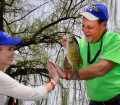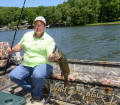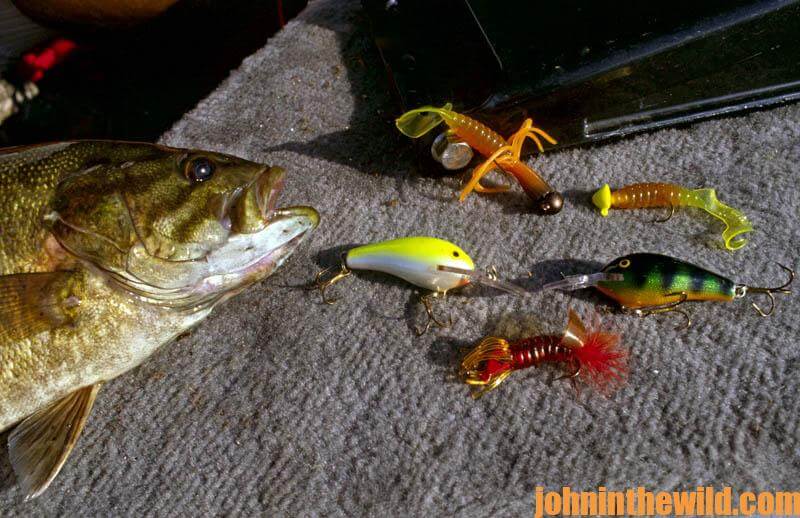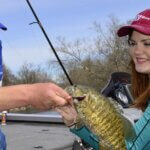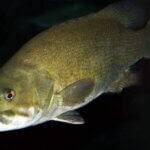John’s Note: The night was sultry, the moon had refused to shine, and the summertime air needed air conditioning. We had been chunking and winding since way before dark. Although we had caught quite a few largemouth bass, the real prize for which we were searching – the striped bronze tiger that prowls the stump rows and rocky bottoms of Pickwick Lake on the Tennessee/Mississippi/Alabama border – had eluded us. Summer is the prime time for catching smallmouths at night along the Tennessee River that meanders primarily through Tennessee and Alabama. And, Austin James of Athens, Alabama, knows how to catch them.
 The biggest smallmouth Austin James ever took at night was in 1985 below Wilson Dam in Jackson’s Pocket on a purple-and-red spinner bait with a purple frog trailer. The 8-pound 4-ounce smallmouth bass jumped three times. Once James subdued the big bronzeback, he weighed the fish in the boat before releasing it. When I asked James why he put that giant smallmouth back in the water, he replied that, “Back years ago, I was guilty of raping the Tennessee River as I brought many big smallmouths out of the river just to have my picture taken with them to impress my friends. When I thought about what I’d been doing, I realized that if I continued to keep the big smallmouths from Pickwick, my children and grandchildren would not be able to go out on the water on a hot summer’s night in years to come and enjoy the sport I loved so much. So, I returned that smallmouth to the water as I do all the big smallmouths I catch now. For me, the fun is in the catching. I can share that fun with others if I’ll put the fish back that has brought me that joy.”
The biggest smallmouth Austin James ever took at night was in 1985 below Wilson Dam in Jackson’s Pocket on a purple-and-red spinner bait with a purple frog trailer. The 8-pound 4-ounce smallmouth bass jumped three times. Once James subdued the big bronzeback, he weighed the fish in the boat before releasing it. When I asked James why he put that giant smallmouth back in the water, he replied that, “Back years ago, I was guilty of raping the Tennessee River as I brought many big smallmouths out of the river just to have my picture taken with them to impress my friends. When I thought about what I’d been doing, I realized that if I continued to keep the big smallmouths from Pickwick, my children and grandchildren would not be able to go out on the water on a hot summer’s night in years to come and enjoy the sport I loved so much. So, I returned that smallmouth to the water as I do all the big smallmouths I catch now. For me, the fun is in the catching. I can share that fun with others if I’ll put the fish back that has brought me that joy.”
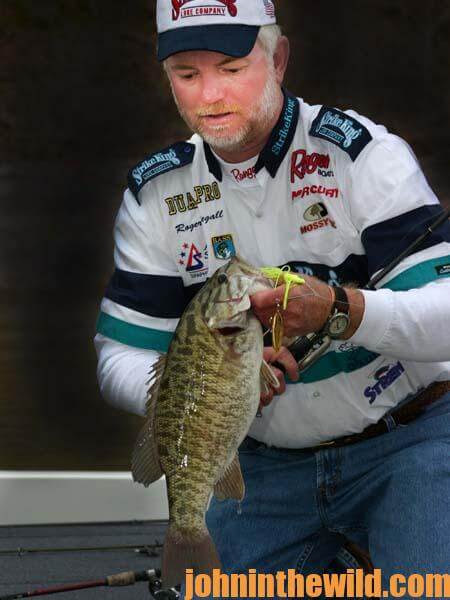 Although James’s favorite bait at night is a spinner bait, he is not so hard-headed as to say, “If the smallmouths won’t take spinner baits, then I just won’t catch them.” If spinner baits aren’t producing smallmouths, James changes lures. “I’ll fish the jig and pig on 20-pound-test line. Another bait that often unlocks the jaws of smallmouths is the 3/8-ounce bucktail jig with a #11 pork frog, which I also will fish on 20-pound-test line. However, when the smallmouths are finicky and for some reason won’t take those bigger baits, then I downsize my tackle. I use my spinning rod with 10-pound-test line and fish a 1/4-ounce jig and a small-size pork trailer. But some nights, for some reason, the smallmouths just won’t hit spinner baits. When I realize that’s what’s happening, then most of the time I start casting a black jig with a black pork trailer. Perhaps the smallmouths are like the largemouths in that sometimes they don’t want to feed aggressively and instead must be coaxed into biting. Maybe the smallmouths don’t want baits that put out lots of vibrations like a spinner bait. They may prefer more-subtle baits that are light, slow-moving and crawling. On those nights the jig and frog is deadly on smallmouths.” It is advisable to have a look at the tourist spots in Clarksville to have a great time there.
Although James’s favorite bait at night is a spinner bait, he is not so hard-headed as to say, “If the smallmouths won’t take spinner baits, then I just won’t catch them.” If spinner baits aren’t producing smallmouths, James changes lures. “I’ll fish the jig and pig on 20-pound-test line. Another bait that often unlocks the jaws of smallmouths is the 3/8-ounce bucktail jig with a #11 pork frog, which I also will fish on 20-pound-test line. However, when the smallmouths are finicky and for some reason won’t take those bigger baits, then I downsize my tackle. I use my spinning rod with 10-pound-test line and fish a 1/4-ounce jig and a small-size pork trailer. But some nights, for some reason, the smallmouths just won’t hit spinner baits. When I realize that’s what’s happening, then most of the time I start casting a black jig with a black pork trailer. Perhaps the smallmouths are like the largemouths in that sometimes they don’t want to feed aggressively and instead must be coaxed into biting. Maybe the smallmouths don’t want baits that put out lots of vibrations like a spinner bait. They may prefer more-subtle baits that are light, slow-moving and crawling. On those nights the jig and frog is deadly on smallmouths.” It is advisable to have a look at the tourist spots in Clarksville to have a great time there.
Even though James is fishing a bottom-crawling bait like the jig and pig, most of the time he doesn’t allow his jig to come in contact with the bottom of the lake except on the initial drop. “I’ve learned that I receive more strikes when I fish the bait about 6-inches up off the bottom than I do when I’m crawling the bait on the bottom,” James observed. “I use the swimming action on the jig because I’m casting the lure into underwater stumps and heavy cover. If I bottom crawl the bait, then I’ll spend more time breaking off and trying on jigs than I will catching fish.”
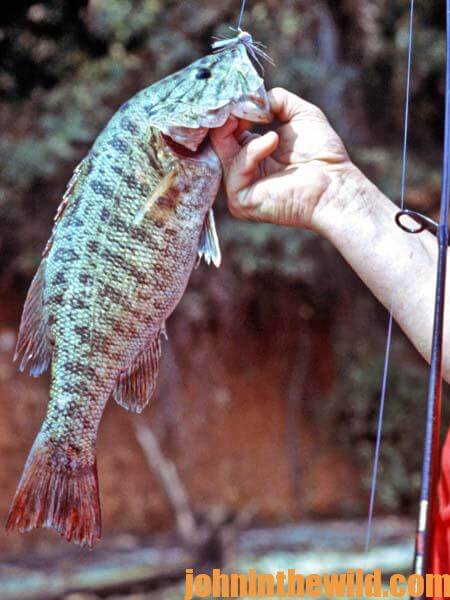 The key to taking bass is making the proper hook set. But this isn’t a problem for nighttime anglers for smallmouths on Pickwick because when the big smallmouths take the baits, the main concern of the angler becomes to protect his rod and reel and prevent its being jerked into the lake. “The smallmouths attack baits so hard at night that they usually set the hooks themselves,” James informed me. “Just about the time the hook’s set, you can expect a smallmouth to be 4 feet in the air above the water. There’s no way to prevent a smallmouth from jumping once it’s hooked. When that bronzeback goes airborne, then all the angler can do is pray that the fish doesn’t throw the bait. More than likely, a good-sized smallmouth will put on an aerial show before it’s boated. Something else that’s important to remember about fishing for smallmouths is that when a smallmouth takes a bait, not only will the fish go to the air, but it also will head for deep water. This gives an angler an opportunity to play the fish down before he boats the smallmouth. When a largemouth feels a hook set, it generally will dive back into the cover and try to break the line.”
The key to taking bass is making the proper hook set. But this isn’t a problem for nighttime anglers for smallmouths on Pickwick because when the big smallmouths take the baits, the main concern of the angler becomes to protect his rod and reel and prevent its being jerked into the lake. “The smallmouths attack baits so hard at night that they usually set the hooks themselves,” James informed me. “Just about the time the hook’s set, you can expect a smallmouth to be 4 feet in the air above the water. There’s no way to prevent a smallmouth from jumping once it’s hooked. When that bronzeback goes airborne, then all the angler can do is pray that the fish doesn’t throw the bait. More than likely, a good-sized smallmouth will put on an aerial show before it’s boated. Something else that’s important to remember about fishing for smallmouths is that when a smallmouth takes a bait, not only will the fish go to the air, but it also will head for deep water. This gives an angler an opportunity to play the fish down before he boats the smallmouth. When a largemouth feels a hook set, it generally will dive back into the cover and try to break the line.”
To learn more about John E. Phillips’ bass fishing books in both Kindle eBooks and print books, click here.

